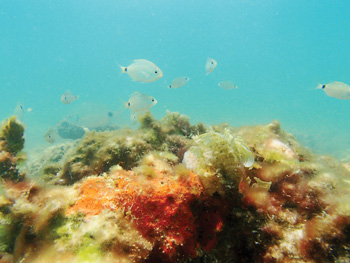Bye bye, reef

CINDY LANE | SUN
The rock reef off Anna Maria Island supports
colorful soft corals, fish and crabs.
Just for the record, there’s no question that we need the beach renourishment that’s planned to begin shortly to make room for the profusion of new visitors who daily discover Anna Maria Island.
Also for the record, Charlie Hunsicker is the Elvis Presley, the Patrick Swayze, the Bruce Lee and the Laird Hamilton of government natural resources administrators, singing, dancing, fighting and conquering the ocean to get us the sand to make our beach wider.
Still, when the new sand is installed seaward of the existing beach, it will be a sad day for snorkelers, surfers, stone crabbers and other fans of the rock reef that intermittently runs parallel to the Island in the Gulf of Mexico.
The county’s beach engineers say that the marine life will be displaced, meaning that the fish, lobsters, starfish, stingrays, sand dollars, crabs and other creatures on the reef will find new homes, not be buried with the rocks.
Granted, we don’t have coral reefs like the ones off Australia or the Caribbean or even the Florida Keys, with vast forests of hard corals in stunning shapes, but our humble rock reef is pretty remarkable.
On it grow colorful soft corals in yellow and orange and purple. Hiding in tunnels created by rocks are some sizeable fish, most of the ordinary silver variety, but – like farther south, in the tropics – some are striped, some are bright yellow, some sport bright blue and yellow, and one, a cowfish, changes its colors from yellow to green to blue, like a chameleon.
The rocks also grow vegetation that manatees munch, and Manatee County’s mascot is often seen dining on the reef.
The rocks cause the waves to break in patterns that make for good surfing; that will be over when the new beach is completed. Fishermen also frequent the reef, casting in between the swimmers and paddleboarders.
Some of the rocks on the reef were once on the beach, in erosion control groins that ran straight out from the buildings into the water, before people realized that the perpendicular groins caused erosion rather than preventing it, creating coves in between the groins.
Some of the rocks aren’t rocks at all, but the concrete bottoms of stone crab traps wrecked on the reef during storms, as identified by a marine archaeologist in “The case of the suspicious submerged squares,” published in Coast Lines on July 13, 2011.
Some are concrete blocks that boaters have dropped over the years so they could tie up and fish. Some of the blocks have turned into fish duplexes, with one or two fish on each side, like the old one-story duplexes in Holmes Beach used to be before investors displaced residents and replaced them with multi-bedroom vacation rentals.
But despite weeks of big pipes, bulldozers with backup alarms, all-night lights and the burial of the reef, beach renourishment is a good thing.
There will be more room for visitors to pitch their tents, and property owners won’t have to worry quite so much about the Gulf rearing up on its hind legs and walking into the living room.
And in a couple of years, when Mother Nature decides to put the furniture back where she wanted it, the rocks will begin to peek out, then seem to grow as our bought-and-paid-for sand recedes, and the fish will come back, and Charlie will have to do his magic all over again.
All because we didn’t follow the lead of the original Native American settlers, who used Anna Maria Island as a fishing camp and built their homes inland.
If you want to see the reef, go now, or – for at least a couple of years – hold your peace.

